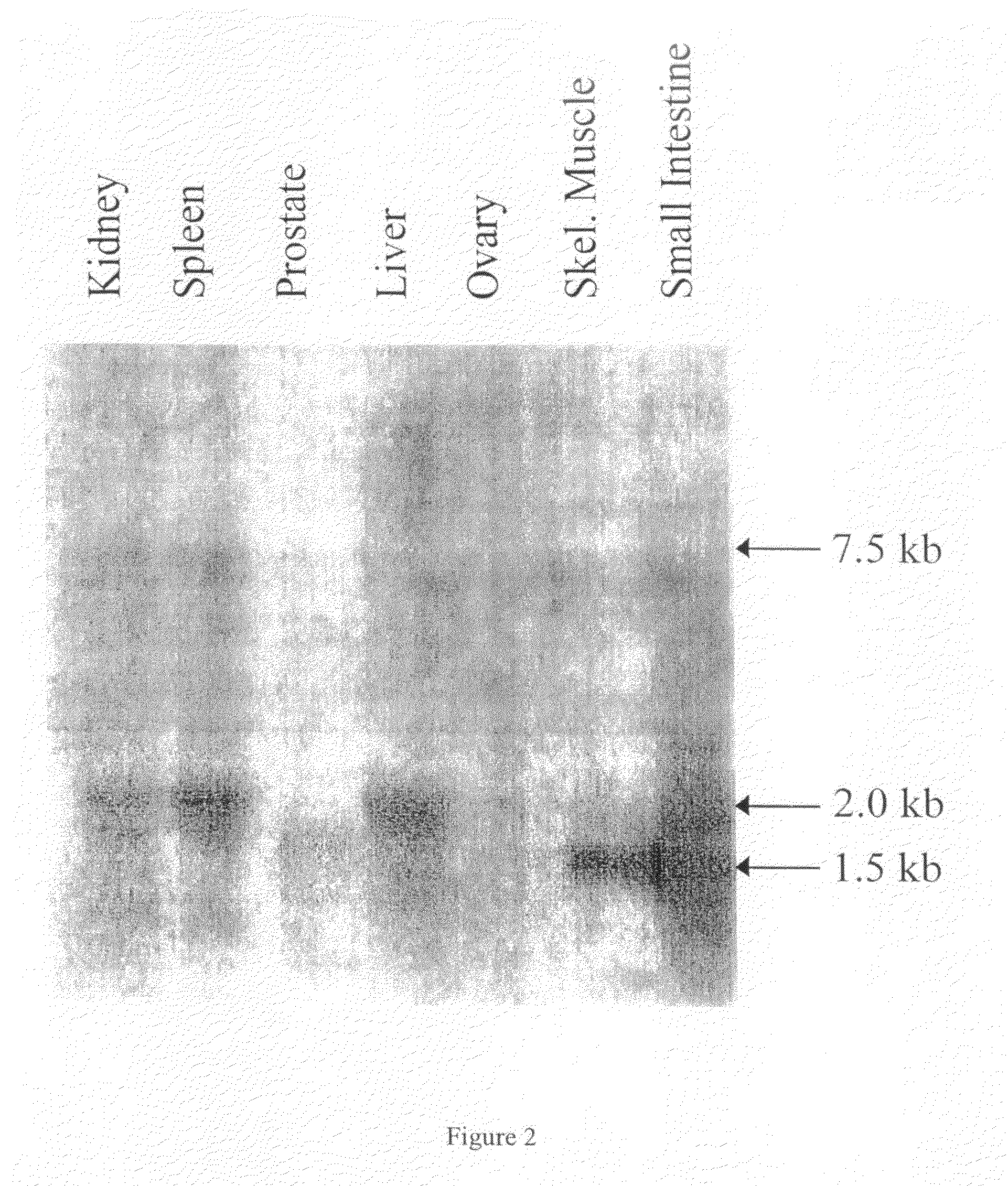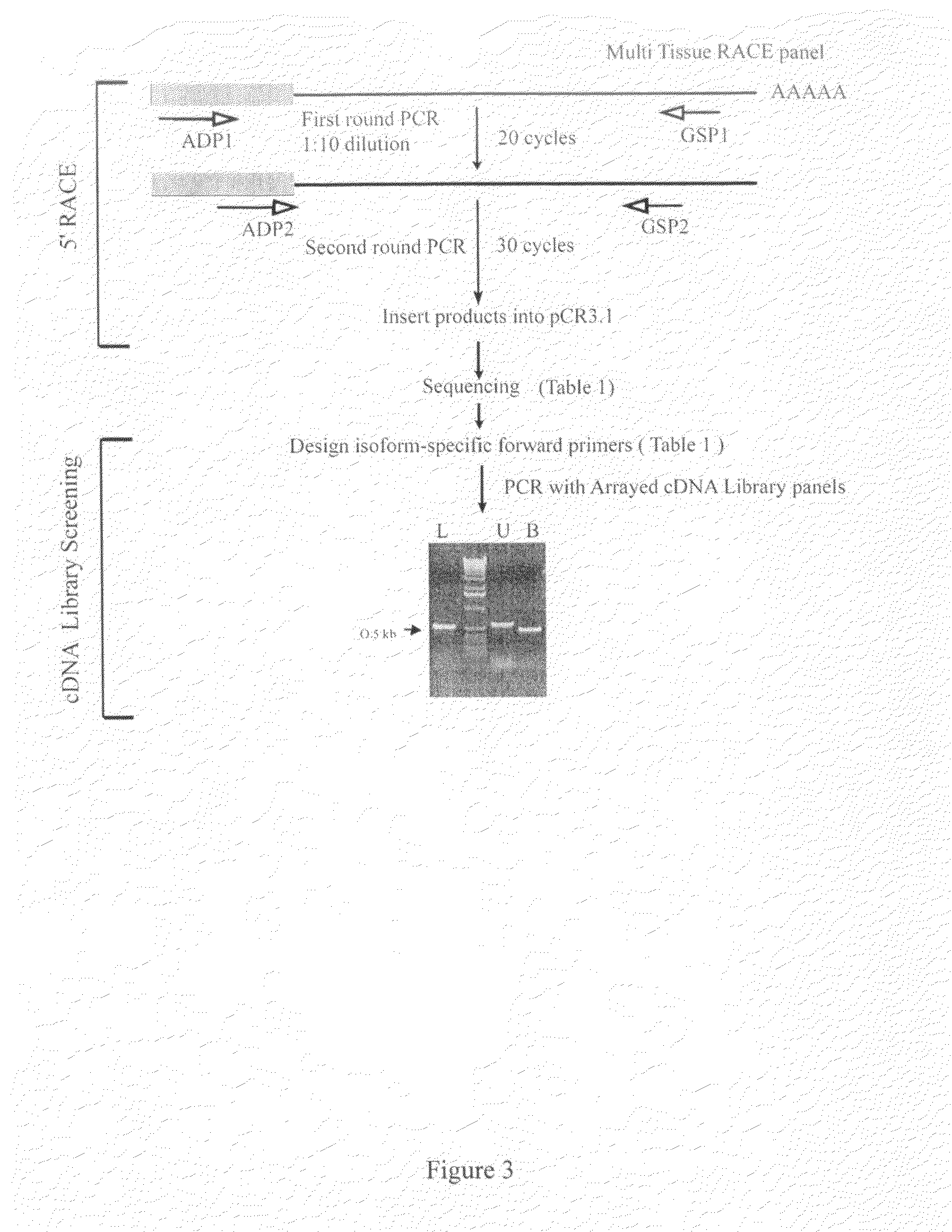Vascular endothelial cell growth inhibitor, VEGI-192a
a growth inhibitor and endothelial cell technology, applied in the field of vascular endothelial cell growth inhibitor, can solve the problems of pathological angiogenesis, difficult to stop, and difficult to initiate once initiated, and achieve the effect of promoting angiogenesis and enhancing angiogenesis
- Summary
- Abstract
- Description
- Claims
- Application Information
AI Technical Summary
Benefits of technology
Problems solved by technology
Method used
Image
Examples
example 1
ELISA Analysis of Human Sera
[0315]Normal human sera of normal male and female adult individuals are obtained from the Lombardi Cancer Center serum bank. Sandwich ELISA was used to measure serum VEGI content. Serum samples (100 μl) or varying amounts of recombinant VEGI protein in 3% BSA were added to 96-well plates coated with a polyclonal anti-VEGI antibody and blocked with 3% BSA. A monoclonal antibody (100 μl, 2 μg / ml) against VEGI (3-12D) was added. Biotinylated anti-mouse IgG antibody (2 μg / ml, Vector laboratories, Burlingame, Calif.) was added, followed by avidin-horseradish peroxidase, with 3,3′,5,5′-tetramethylbenzidine (Vector laboratories) as substrate. The samples were incubated at room temperature for 10 min, the reaction terminated with 50 μl 1 M H2SO4, then analyzed at 450 nm with a spectrophotometric plate reader, using the standard curve y=−0.72+0.409*log(x). Standard protein range used was 0.32-1000 ng / ml.
example 2
Northern Blotting
[0316]Multi-tissue Northern blots and multi-tissue dot-blot panels (Clontech, Palo Alto, Calif.) were hybridised in ExpressHyb solution (Clontech) with double-stranded cDNA probes. The full length VEGI-174 probe used was a Hind III-BamHI cDNA fragment (GenBank Accession #AF03990) in pcDNA3.1 (Invtrogen, Carlsbad, Calif.). For isoform-specific probes, a 297-bp VEGI-251 template encoding its N-terminal 99 amino acids was made by PCR amplification, and labeled with 32P-dCTP by random priming (Life Technologies, Invitrogen, Calif.). The VEGI-174 specific probe corresponding to its N-terminal 22 amino acids was made by end-labeling a 66-bp PCR product. The blots were hybridized at 42° C. overnight and washed in wash buffer 1 (2×SSC, 0.1% Sodium lauryl sulfate) and wash buffer 2 (1×SSC, 1% SDS) at 42° C. followed by autoradiography at −70° C. with an intensifying screen.
example 3
5′RACE and VEGI Isoform Cloning
[0317]5′ VEGI sequences were amplified from a multi-tissue RACE panel (ORIgene, Rockville, Md.) according to the manufacturer's instructions. This panel contains cDNA samples prepared from 24 individual human tissues, with an adapter ligated to the 5′ ends of the cDNAs. Two rounds of nested PCR were performed using two pairs of oligonucleotide primers. In the first round of PCR, an adapter primer ADP1,5′CGGAATTCGT CACTCAGCG 3′ (SEQ ID NO:8) and a VEGI gene-specific primer GSP1,5′CCCGGATCCT ATAGTAAGAA GGCTCC 3′ (SEQ ID NO:9) were used. The reaction products were then diluted 1:10 with water. The diluted PCR samples were then used for the second round of PCR with another adapter primer, ADP2,5′AGCGCGTGAA TCAGATCG3′ (SEQ ID NO:10), and a VEGI gene-specific primer, GSP2,5′CGGTGGATCC CGAGTTTGTC TCACAACTG3′ (SEQ ID NO:11). The PCR products were resolved on an agarose gel, purified, and sequenced on an ABI automatic sequencer.
PUM
 Login to View More
Login to View More Abstract
Description
Claims
Application Information
 Login to View More
Login to View More - R&D
- Intellectual Property
- Life Sciences
- Materials
- Tech Scout
- Unparalleled Data Quality
- Higher Quality Content
- 60% Fewer Hallucinations
Browse by: Latest US Patents, China's latest patents, Technical Efficacy Thesaurus, Application Domain, Technology Topic, Popular Technical Reports.
© 2025 PatSnap. All rights reserved.Legal|Privacy policy|Modern Slavery Act Transparency Statement|Sitemap|About US| Contact US: help@patsnap.com



